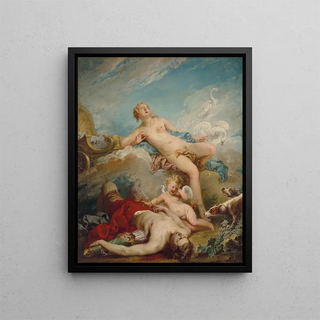Art print | Venus discovering Adonis dead - François Boucher


View from behind

Frame (optional)
In the rich and vibrant universe of baroque art, the "Venus discovering the dead Adonis" art print by François Boucher stands out for its emotional depth and refined composition. This tragic scene, where love and loss intertwine, invites the viewer to immerse themselves in a visual narrative where beauty and pain coexist. The depiction of Venus, goddess of love, discovering her lifeless lover, Adonis, is a poignant exploration of themes of passion and fatality. Boucher, with his unmatched skill, manages to capture this moment of despair with a delicacy that transcends time, offering an unforgettable aesthetic experience.
Style and uniqueness of the work
François Boucher's style is imbued with a lightness and sensuality characteristic of rococo. In "Venus discovering the dead Adonis," every brushstroke seems to dance on the canvas, revealing a palette of soft and shimmering colors. The flowing drapery, delicate facial expressions, and meticulous details of natural elements create an atmosphere that is both intimate and dramatic. The composition, skillfully orchestrated, guides the viewer's gaze through the scene, highlighting the interaction between the figures and the environment. Boucher uses light and shadow with remarkable mastery, emphasizing the emotions and tension of this tragic moment. This work is a true ode to the beauty and fragility of human feelings, where each element contributes to the overall harmony of the scene.
The artist and his influence
François Boucher, born in 1703, is one of the emblematic figures of 18th-century France, and his work has profoundly influenced the development of rococo style. Raised in an artistic environment, he knew how to establish himself as a master of painting, notably thanks to his ability to combine sensuality and elegance. His work, often inspired by mythology and literature, managed to seduce the court of Louis XV, making him the official painter of the monarchy. Boucher also played a key role in redefining the artistic themes of his time, highlighting scenes

Matte finish

View from behind

Frame (optional)
In the rich and vibrant universe of baroque art, the "Venus discovering the dead Adonis" art print by François Boucher stands out for its emotional depth and refined composition. This tragic scene, where love and loss intertwine, invites the viewer to immerse themselves in a visual narrative where beauty and pain coexist. The depiction of Venus, goddess of love, discovering her lifeless lover, Adonis, is a poignant exploration of themes of passion and fatality. Boucher, with his unmatched skill, manages to capture this moment of despair with a delicacy that transcends time, offering an unforgettable aesthetic experience.
Style and uniqueness of the work
François Boucher's style is imbued with a lightness and sensuality characteristic of rococo. In "Venus discovering the dead Adonis," every brushstroke seems to dance on the canvas, revealing a palette of soft and shimmering colors. The flowing drapery, delicate facial expressions, and meticulous details of natural elements create an atmosphere that is both intimate and dramatic. The composition, skillfully orchestrated, guides the viewer's gaze through the scene, highlighting the interaction between the figures and the environment. Boucher uses light and shadow with remarkable mastery, emphasizing the emotions and tension of this tragic moment. This work is a true ode to the beauty and fragility of human feelings, where each element contributes to the overall harmony of the scene.
The artist and his influence
François Boucher, born in 1703, is one of the emblematic figures of 18th-century France, and his work has profoundly influenced the development of rococo style. Raised in an artistic environment, he knew how to establish himself as a master of painting, notably thanks to his ability to combine sensuality and elegance. His work, often inspired by mythology and literature, managed to seduce the court of Louis XV, making him the official painter of the monarchy. Boucher also played a key role in redefining the artistic themes of his time, highlighting scenes






